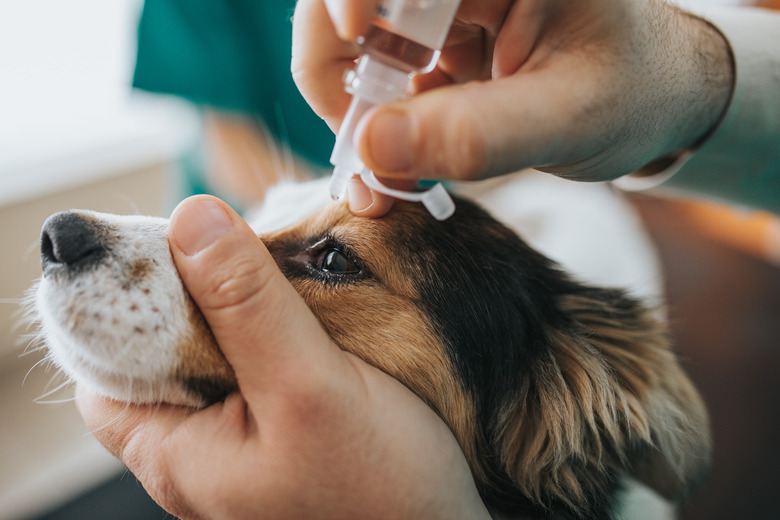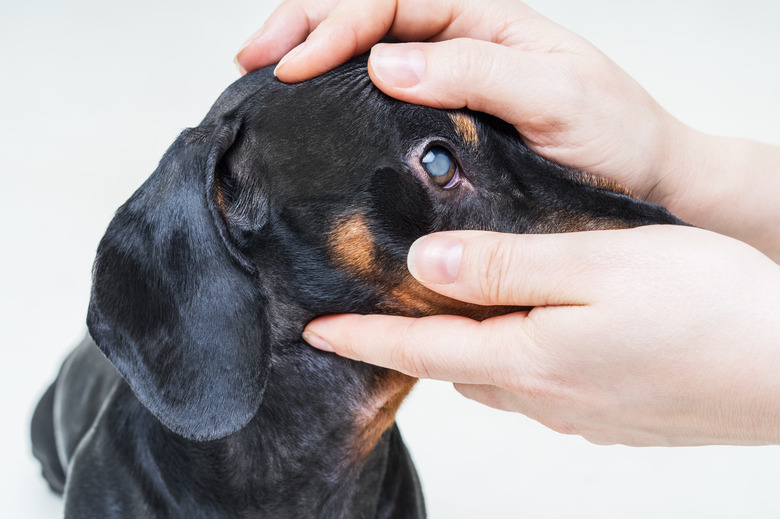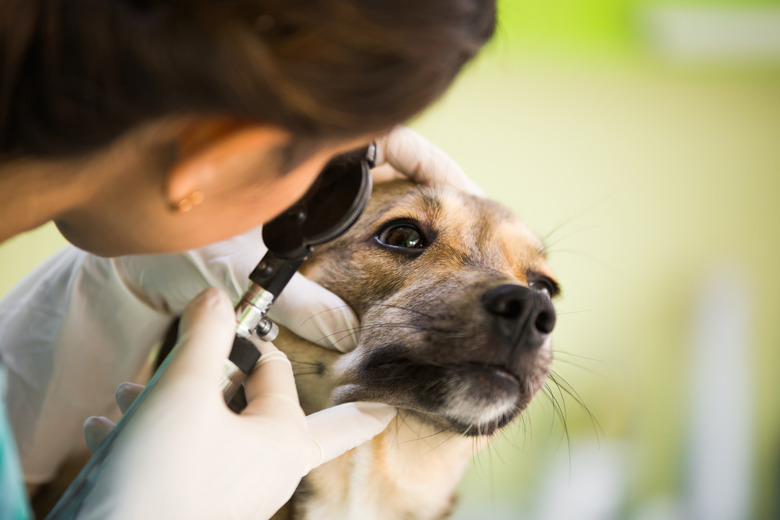Dog Eye Stye? Home Remedies To Soothe Your Pup's Irritated Eye
We may receive a commission on purchases made from links.
Cuteness may earn compensation through affiliate links in this article.
Most people have had a stye on their eyelid at one time or another. It's amazing how something so small can hurt so much. Whether the stye is on a human's eyelid or a dog's eyelid, it can be an unpleasant experience that must be treated to help it heal. The best thing to do for a dog with a stye is to keep their eyes clean.
What is an eye stye on a dog's eyelid?
What is an eye stye on a dog's eyelid?
A dog eye stye, also known as a hordeolum, is pretty much the same as a human eye stye. It's often an infection that shows up as a red, painful bump on a dog's eyelid or looks like a pimple on the eyelid. A stye won't impair the dog's vision, but it will hurt a lot.
One important difference between a human stye and a dog stye is that a dog eye stye is not contagious. However, human eye styes are highly contagious. Neither pets nor humans can get a stye from a dog who has one.
While most simple styes self-resolve within a few days, a veterinarian should be consulted if the dog is in pain or if the symptoms get worse.
Some signs that a dog is in pain and should see a veterinarian include frequent blinking or holding the eye shut, anti-social or aggressive behavior, not eating, shaking, or trembling. Likewise, if there is yellow or green discharge coming from the eye, the dog needs to be seen by a veterinarian as soon as possible. Dogs with an eye stye may rub their eyes with their paws or rub their face against the floor or furniture, aggravating the condition.
Diagnosing eye styes in dogs
Diagnosing eye styes in dogs
If a dog has a bump or pimplelike growth on the eyelid, is pawing at their eye, and appears to be suffering from dry eye or general irritation, there's a good chance that it's an eye stye. The surface of the eye may appear red or swollen, as if the dog has pink eye. If the stye has ruptured, there may be crusting around the eyelid.
Eye styes can appear quickly and can disappear just as quickly. It's important to be aware that there are other more serious conditions that mimic the appearance of an eye stye in dogs, so consulting a veterinarian is the best way to get a diagnosis.
While a simple eye stye can often be treated with eye washes, warm compresses, and other simple home remedies, a more serious infection will require veterinary care. This might include medicated eye drops, topical antibiotics, oral antibiotics, or even surgical removal.
Home remedies for a dog eye stye
Home remedies for a dog eye stye
Although most styes heal on their own, there are some home treatments that may help speed up the process and alleviate the pain. Warm compresses can help reduce swelling and pain. They soften the stye and the pus inside it, which can encourage drainage. Soak a soft washcloth in warm water, squeeze enough out so that it's not dripping, and gently hold the warm cloth on the dog's eyelid. Do this for five minutes three or four times a day. Talking or singing softly and rubbing the dog's belly will help keep them calm and still and might even lull them to sleep.
Another option is to prepare a tea bag compress and apply it when the soaked tea bag is cool to the touch. Chamomile is a good choice because it has anti-inflammatory and antimicrobial properties. Doing this for 15 minutes at a time a couple of times a day is optimal, but if the dog won't stay still for that long, try doing it three or four times a day for five to 10 minutes. Dipping a soft cloth in a cup of cooled brewed tea and applying it to the eyelid for several minutes four times a day can also work.
Over-the-counter solutions for a stye on my dog
Over-the-counter solutions for a stye on my dog
A general eye wash product, which can be found at any drug store, can also provide some relief. These are made for humans but will work for dogs' eyes as well. Additionally, over-the-counter artificial tears, like Systane or Refresh Tears, can help. Styes are often reactions to irritants, like bacteria and dead skin cells, so rinsing this stuff away and adding a tear-like lubricant can help.
Of course, there are also over-the-counter products designed specifically for pets that offer a safe solution for rinsing a dog's eyes. Start with washing the dog's eye with Nutri-Vet Eye Rinse to clear away any debris. The mild boric acid solution is particularly effective for eye infections and reducing microbial activity. The mild, soothing product can be used daily, especially after a dog is exposed to lake water, chlorine, allergens, or other eye irritants.
MicrocynAH Ophthalmic Gel can help to soothe burning and irritation. Just apply a drop or two twice a day or place a dollop of Terramycin Antibiotic Ophthalmic Ointment in the corner of the eye. However, Terramycin requires a prescription for people living in California. You should talk with a veterinarian before applying Terramycin. Since it's an antibiotic, once you start your pet on it, a full course needs to be done. That duration needs to be determined by a veterinarian. Misusing antibiotics contributes to antibiotic resistance in people and animals.
What not to do for a stye on a dog's eye
What not to do for a stye on a dog's eye
Never try to pop a dog's eye stye. It will cause the dog an enormous amount of pain and can cause greater problems if some of the pus retreats further into the eyelid. Plus you're likely to scratch their cornea in the process.
Don't force any treatment on the dog. Be sensitive and responsive to their level of tolerance for any home remedy.
The part of a dog's brain that controls smell is 40 times larger than the part of the human brain that controls smell. Their sense of smell is 10,000 to 100,000 times stronger than a human's, so be aware that something that smells mild to people may be overwhelming to dogs.
Not all dogs will be comfortable with eye washes or compresses. With no treatment, a stye will generally heal on its own within four to 14 days. Contact a veterinarian if the dog is in pain, if swelling or redness occurs, or if they develop yellow or green ocular discharge.
How do dogs get styes in their eyes?
How do dogs get styes in their eyes?
There are several reasons a dog may get an eye stye. Bacterial infections can cause eye styes when the oil gland becomes infected, such as with a bacterium called Staphylococcus aureus.
The hair follicles close to the eyelid can sometimes get clogged with dirt, oil, and other debris, such as dead skin cells. Even an ingrown eyelash can get infected, leading to problems.
Is a stye and a cyst on a dog's eye the same thing?
Is a stye and a cyst on a dog's eye the same thing?
No, an eye stye and a cyst on a dog's eye are not the same thing. At first glance, they may appear similar. Much like a stye, a cyst appears as a red, swollen bump, usually on the upper eyelid. However, that's where the similarities end.
In some cases, the Meibomian glands, which are located around the edge of the eyelid, become clogged. This causes the formation of a chalazion, or eyelid cyst, which is not infectious and generally not painful.
Meibomian glands secrete a substance that helps to keep the tear film healthy. However, these glands can become inflamed due to other underlying causes, such as allergies. Occasionally, a mass or cyst will grow. A Meibomian gland adenoma is one such type of mass. Meibomian masses are most common in older dogs or middle-age dogs.
There are also other types of growths or tumors that might initially look like a stye but are far more serious. These include eyelid melanomas and sebaceous adenocarcinomas, a type of cancer that has the potential to spread to the lymph nodes.
Papillomas, which are often viral in origin, are more common in young dogs but can occur in dogs of any age. Conjunctivitis or corneal ulcers may also cause redness or swelling, and these will need to be treated by a veterinarian.
How to prevent dog eye styes
How to prevent dog eye styes
Unfortunately, there is no sure way to prevent dogs from getting eye styes, though keeping a dog's face and eyes clean may help minimize the risk of an eye stye. Wind can be an eye irritant and can also allow foreign bodies to blow into the eye, so keeping a dog's head inside the car while driving may also help to lessen the risk of an eye stye.
Some dogs are prone to getting styes in their eyes; others may get one and never have one again. If a dog is prone to eye issues, has a weakened immune system, or has had previous eye trauma, they may benefit from protective eyewear, such as sunglasses or goggles.
The bottom line
The bottom line
Eye styes in dogs are fairly common, and while they are usually not serious, they can be very painful. Warm compresses and eye washes may help, but in more serious cases, the dog may need to see a veterinarian for antibiotics, medicated eye drops, or even surgery if the stye is actually a more dangerous type of growth. While there is no surefire way to prevent eye styes, keeping a dog's face and eyes clean and protecting their eyes from wind may help minimize the risk of an eye stye.



